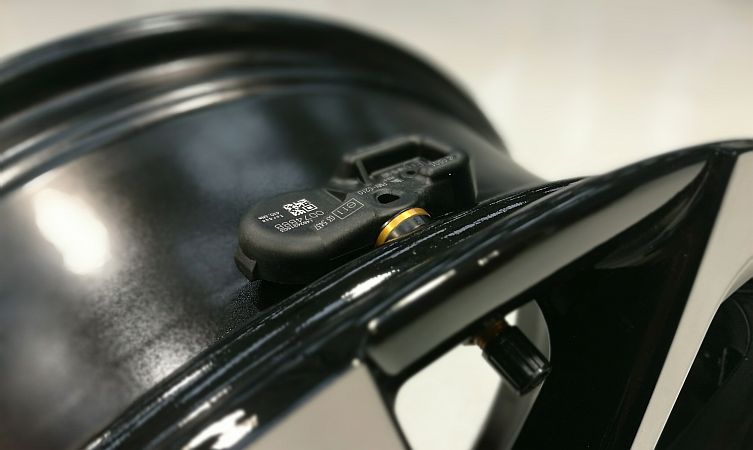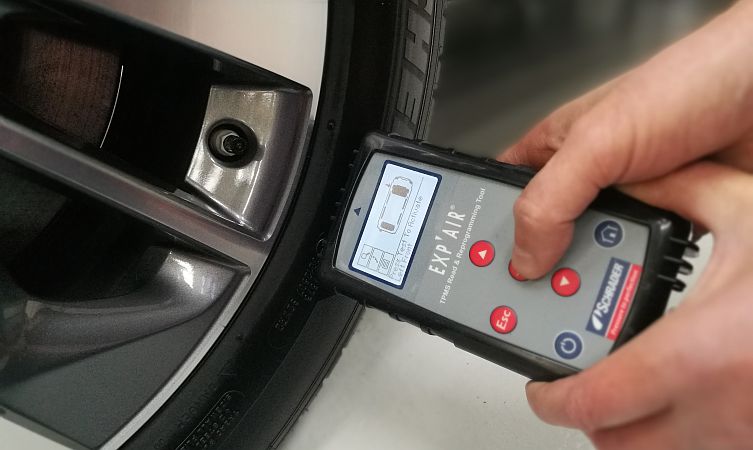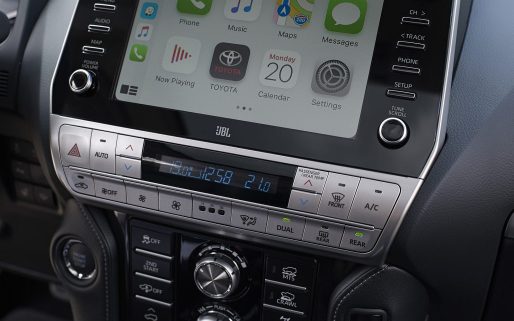Has a tyre pressure warning light appeared on your dashboard? The yellow symbol looks like the cross-section of a tyre with an exclamation mark inside. But what does the warning light mean, and what should you do about it?

What is the tyre pressure warning light?
The warning light is an alert message to the driver that there may be a loss of air pressure from one or more of the vehicle’s tyres. It comes from the Tyre Pressure Monitoring System (TPMS), an active safety technology that has become a legal requirement for all newly launched and factory updated passenger cars sold in Europe since November 2014.
Tyres represent the only contact your vehicle has with the ground, so maintaining the correct tyre pressure has many safety and efficiency benefits. These include:
- Prevents accidents caused by a critical decrease in tyre pressure
- Helps the vehicle perform predictably
- Saves fuel
- Reduces emissions
- Optimises tyre wear
How does a Tyre Pressure Monitoring System work?
There are two types of TPMS: direct and indirect. Direct systems are installed in the majority of Toyota’s current passenger car line-up, and this method uses a battery-powered sensor integrated into the valve assembly (see images below) to physically measure air pressure from within the tyre cavity itself.

Data from the sensor in each wheel is transmitted wirelessly to a control module connected to the car’s central computer, which prompts a visible alert for the driver if any of the tyres lose pressure. The control module is programmed with the unique serial numbers of the valves within the car’s system. This ensures that the TPMS assembly in each wheel only communicates with its host control module.

The only exception within Toyota’s passenger car line-up is the Proace Verso MPV. This model is equipped with an indirect system, which uses the existing wheel speed sensors within the anti-lock braking system to ‘measure’ tyre pressure by detecting differences in the rate of wheel rotation. A tyre with less air pressure will have a smaller circumference and therefore spin at a faster rate than a wheel that has not lost air pressure.
Data from the wheel speed sensors is communicated directly to the ABS control unit, which prompts a visible alert for the driver if any wheel speed abnormalities are detected.
What should I do if the tyre pressure warning light comes on?
If the tyre pressure warning light comes on, the air pressure in at least one of your tyres will have dropped below a minimum tolerance level – often a deflation of around 20-25%. This may indicate a leak, puncture, or some other kind of damage.
Dramatic changes in ambient temperature, such as driving from a snow-capped mountain to a warm and sheltered valley, can occasionally cause direct systems to prompt an alert until the temperature has stabilised. Similarly, indirect systems can occasionally mistake uneven tyre wear for a fluctuation in tyre pressure.
Irrespective of the circumstances, if the TPMS warning light comes on you should pull into a safe area and visually check the tyres. If any appear to be deflated yet undamaged you should try to re-inflate them to the correct pressure and reset the TPMS (see subheading below).
If the tyre has sustained more serious damage, it will be necessary to either continue your journey on the spare wheel, carry out a temporary repair using a tyre repair kit, or call an emergency breakdown service for a lift to a tyre centre.

How do I turn off the tyre pressure warning light?
Use the box below to identify the type of TPMS fitted to your car (only current models are listed below). You will also need to know whether the reset function is accessed via a button or sub-menu within the main display.
Once you have accessed the right sub-menu, instructions for resetting the TPMS will be shown within the main display. For those with a physical button, you simply need to turn the ignition on, then press and hold the TPMS button. The warning light will flash a couple of times and then extinguish, at which point the system has been reset.
| MODEL | TPMS TYPE | RESET ACCESS | LOCATION |
| Aygo X | Direct | Software menu | Vehicle Settings menu on Multi-info Display |
| Yaris | Direct | Software menu | Vehicle Settings menu on Multi-info Display |
| Yaris Cross | Direct | Software menu | Vehicle Settings menu on Multi-info Display |
| Corolla | Direct | Software menu | Vehicle Settings menu on Multi-info Display |
| Toyota C-HR | Direct | Software menu | Vehicle Settings menu on Multi-info Display |
| bZ4X | Direct | Software menu | Vehicle Settings menu on Multi-info Display |
| RAV4 | Direct | Software menu | Vehicle Settings menu on Multi-info Display |
| RAV4 Plug-in | Direct | Software menu | Vehicle Settings menu on Multi-info Display |
| GR86 | Direct | Button | Lower dashboard on passenger’s side |
| GR Supra | Direct | Software menu | Vehicle Status menu on Supra Command |
| Land Cruiser | Direct | Button | Under dashboard on driver’s side |
| Highlander | Direct | Software menu | Vehicle Settings menu on Multi-info Display |
| Proace Verso | Indirect | Software menu | Driving Functions menu on Pro-Touch display |
| Mirai | Direct | Software menu | Vehicle Settings menu on Multi-info Display |
What should happen if I replace any tyres?
Direct: The condition and function of the TPMS valve and sensor assembly should be checked each time the tyres are replaced. This will involve a physical inspection and electronic diagnosis using a proprietary technology (example device in image below).

The integrated battery has a life expectancy of around ten years and cannot be replaced. Electronic diagnosis should reveal the health of the battery, which will help you decide whether to replace the entire unit at the same time as the tyre.
Although the main valve assembly is robust, parts exposed to the atmosphere can deteriorate over time. So if the battery level is adequate and the main unit is being retained, it would still be wise to have the grommets, washers, collars and cores (see image below) replaced as a matter of course.

Indirect: As this system is not directly related to the tyres, no further measures are needed, assuming the tyres are being replaced on a like-for-like basis. However, it is always wise to replace the valves when changing tyres.
Will changing the wheels affect the TPMS?
Not if your car features indirect TPMS measuring. In which case, you can switch to and from winter tyres with no additional system programming.
Due to the accuracy and complexity of direct measuring, the TPMS control module is designed to recognise and communicate with only one set of wheels at a time. So if you regularly switch to and from winter wheels it will be necessary for a qualified technician to reprogramme the control module through the vehicle’s OBD port.

There are occasions when it may be necessary to drive on a wheel that is not equipped with a TPMS valve, such as after a puncture when the spare wheel is fitted. Under such circumstances, the warning light will remain illuminated. The vehicle or tyre monitoring system will not be damaged but the vehicle cannot pass its annual MoT test if the warning light is on.
Do I still have to check my tyres manually?
Although TPMS is designed to deliver a safety alert in the event of a significant loss of tyre pressure, it does not replace manual inspections. Each tyre should be regularly checked to see if it is inflated to the correct air pressure and has sufficient tread depth.







Hello,
I recently bought a set of rims with mounted wheels and new TPMS sensors for my Corolla Cross 2024.
The user manual says: “When new tire pressure warning valves and transmitters
are installed, new ID codes must be registered in the tire pressure warning computer.
– ID codes can be registered by yourself, but depending on the driving conditions and driving environment, registration may take some time to complete.”
Does this mean, that no special equipment required, and that the new TPMS sensors will register in TPWS computer of the car when following the steps in manual (e. g. 1. park the car for 20 minutes; 2. in vehicle settings TPWS menu “Add new valve / ID”, 3. choose tire set, 4. Drive with 40km/hour for 10-30 minutes)
Thanks in Advance for your support.
Hi Vahan, thanks for your comment.
We cannot assist with your query as Toyota UK, please contact Toyota in your area directly.
Thanks,
Toyota UK
I changed ‘15 rims on my Yaris D4D 2015 with another’16 inch with tyres 195/50/16 and TPMS stays on all the time, no matter I do to reset it. No pressure problems, leaks or damage. Don’t know what do to to remove that light from the board.
Hi Aleksandar, thanks for your comment.
Your local Toyota Centre will need to take a closer look at this.
Thanks,
Our Toyota Yaris, which we purchased in March this year, has the tyre pressure warning light activated. This came on when the weather turned cold. I, therefore, checked the pressures of all 4 wheels. Each one was reading high (around 36psi) so I corrected the pressures according to the label inside the offside font door – front 32; rear 29psi. This now shows on the multifunction display as 2.2 and 2.0bar. However, the warning light is still on.
How do I reset the monitors so the light is extinguished?
Thanks in advance for your advice.
Hi Geoff, thanks for getting in touch.
Your local Toyota Centre will need to take a look at this to ensure there are no issues with the sensors.
Thanks,
My Toyota Corolla (2019 – 1.8 hybrid) has a fault. I have checked the tyre pressure manually and it is correct but the warning light persists even after resetting. What is the cause and fix?
Hi there,
Your local Toyota Centre will need to take a look at this in person.
Thanks,
Hi Sean,
Thanks for your comment.
You can view this via your owners manual you can follow the link here:
https://www.toyota.co.uk/customer/manuals?srsltid=AfmBOorETcTzmd-OuerqrXivebtY7pX3CX_ab99-SNWHQn4nIWwlYyaC
Thanks,
Hi Sean,
Thanks for contacting us.
If you can provide us with your vehicle registration number, we would be happy to check this for you.
Many thanks
Hi If the tyre pressure sensor breaks off inside the tyre of my 23 plate Toyota Corolla will it show up as a pressure fault.
Hi John,
Thanks for your question.
Yes, it’s possible that this could show up as a pressure fault. If this were to happen we would recommend contacting your nearest Toyota Centre for further assistance.
Many thanks,
Toyota UK